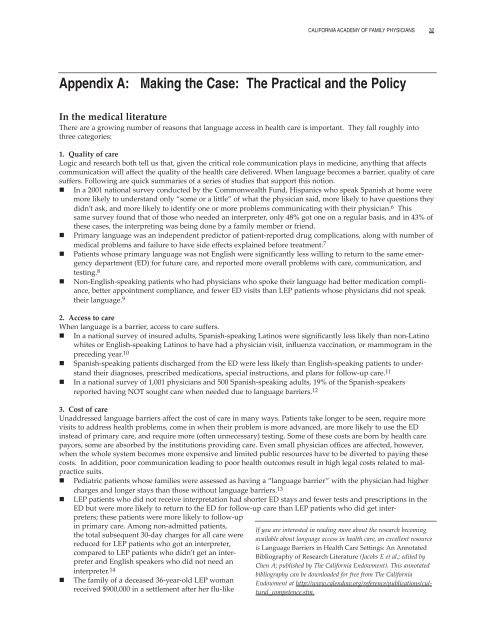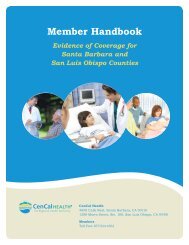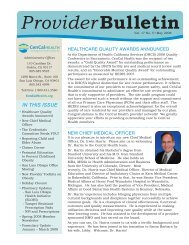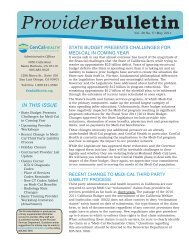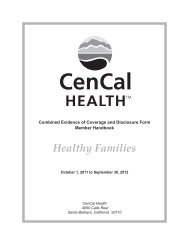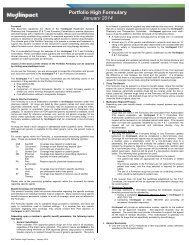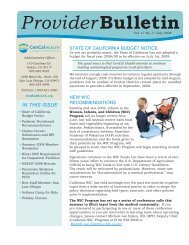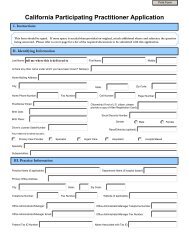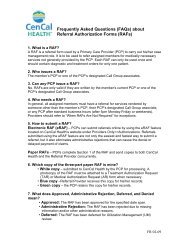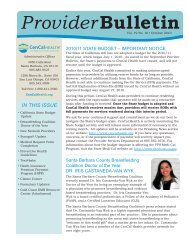Addressing Language Access Issues in Your Practice: A Toolkit for ...
Addressing Language Access Issues in Your Practice: A Toolkit for ...
Addressing Language Access Issues in Your Practice: A Toolkit for ...
Create successful ePaper yourself
Turn your PDF publications into a flip-book with our unique Google optimized e-Paper software.
CALIFORNIA ACADEMY OF FAMILY PHYSICIANS 32<br />
Appendix A: Mak<strong>in</strong>g the Case: The Practical and the Policy<br />
In the medical literature<br />
There are a grow<strong>in</strong>g number of reasons that language access <strong>in</strong> health care is important. They fall roughly <strong>in</strong>to<br />
three categories:<br />
1. Quality of care<br />
Logic and research both tell us that, given the critical role communication plays <strong>in</strong> medic<strong>in</strong>e, anyth<strong>in</strong>g that affects<br />
communication will affect the quality of the health care delivered. When language becomes a barrier, quality of care<br />
suffers. Follow<strong>in</strong>g are quick summaries of a series of studies that support this notion.<br />
• In a 2001 national survey conducted by the Commonwealth Fund, Hispanics who speak Spanish at home were<br />
more likely to understand only “some or a little” of what the physician said, more likely to have questions they<br />
didn’t ask, and more likely to identify one or more problems communicat<strong>in</strong>g with their physician. 6 This<br />
same survey found that of those who needed an <strong>in</strong>terpreter, only 48% got one on a regular basis, and <strong>in</strong> 43% of<br />
these cases, the <strong>in</strong>terpret<strong>in</strong>g was be<strong>in</strong>g done by a family member or friend.<br />
• Primary language was an <strong>in</strong>dependent predictor of patient-reported drug complications, along with number of<br />
medical problems and failure to have side effects expla<strong>in</strong>ed be<strong>for</strong>e treatment. 7<br />
• Patients whose primary language was not English were significantly less will<strong>in</strong>g to return to the same emergency<br />
department (ED) <strong>for</strong> future care, and reported more overall problems with care, communication, and<br />
test<strong>in</strong>g. 8<br />
• Non-English-speak<strong>in</strong>g patients who had physicians who spoke their language had better medication compliance,<br />
better appo<strong>in</strong>tment compliance, and fewer ED visits than LEP patients whose physicians did not speak<br />
their language. 9<br />
2. <strong>Access</strong> to care<br />
When language is a barrier, access to care suffers.<br />
• In a national survey of <strong>in</strong>sured adults, Spanish-speak<strong>in</strong>g Lat<strong>in</strong>os were significantly less likely than non-Lat<strong>in</strong>o<br />
whites or English-speak<strong>in</strong>g Lat<strong>in</strong>os to have had a physician visit, <strong>in</strong>fluenza vacc<strong>in</strong>ation, or mammogram <strong>in</strong> the<br />
preced<strong>in</strong>g year. 10<br />
• Spanish-speak<strong>in</strong>g patients discharged from the ED were less likely than English-speak<strong>in</strong>g patients to understand<br />
their diagnoses, prescribed medications, special <strong>in</strong>structions, and plans <strong>for</strong> follow-up care. 11<br />
• In a national survey of 1,001 physicians and 500 Spanish-speak<strong>in</strong>g adults, 19% of the Spanish-speakers<br />
reported hav<strong>in</strong>g NOT sought care when needed due to language barriers. 12<br />
3. Cost of care<br />
Unaddressed language barriers affect the cost of care <strong>in</strong> many ways. Patients take longer to be seen, require more<br />
visits to address health problems, come <strong>in</strong> when their problem is more advanced, are more likely to use the ED<br />
<strong>in</strong>stead of primary care, and require more (often unnecessary) test<strong>in</strong>g. Some of these costs are born by health care<br />
payors, some are absorbed by the <strong>in</strong>stitutions provid<strong>in</strong>g care. Even small physician offices are affected, however,<br />
when the whole system becomes more expensive and limited public resources have to be diverted to pay<strong>in</strong>g these<br />
costs. In addition, poor communication lead<strong>in</strong>g to poor health outcomes result <strong>in</strong> high legal costs related to malpractice<br />
suits.<br />
• Pediatric patients whose families were assessed as hav<strong>in</strong>g a “language barrier” with the physician had higher<br />
charges and longer stays than those without language barriers. 13<br />
• LEP patients who did not receive <strong>in</strong>terpretation had shorter ED stays and fewer tests and prescriptions <strong>in</strong> the<br />
ED but were more likely to return to the ED <strong>for</strong> follow-up care than LEP patients who did get <strong>in</strong>terpreters;<br />
these patients were more likely to follow-up<br />
<strong>in</strong> primary care. Among non-admitted patients,<br />
the total subsequent 30-day charges <strong>for</strong> all care were<br />
reduced <strong>for</strong> LEP patients who got an <strong>in</strong>terpreter,<br />
compared to LEP patients who didn’t get an <strong>in</strong>terpreter<br />
and English speakers who did not need an<br />
<strong>in</strong>terpreter. 14<br />
• The family of a deceased 36-year-old LEP woman<br />
received $900,000 <strong>in</strong> a settlement after her flu-like<br />
If you are <strong>in</strong>terested <strong>in</strong> read<strong>in</strong>g more about the research becom<strong>in</strong>g<br />
available about language access <strong>in</strong> health care, an excellent resource<br />
is <strong>Language</strong> Barriers <strong>in</strong> Health Care Sett<strong>in</strong>gs: An Annotated<br />
Bibliography of Research Literature (Jacobs E et al.; edited by<br />
Chen A; published by The Cali<strong>for</strong>nia Endowment). This annotated<br />
bibliography can be downloaded <strong>for</strong> free from The Cali<strong>for</strong>nia<br />
Endowment at http://www.calendow.org/reference/publications/cultural_competence.stm.


